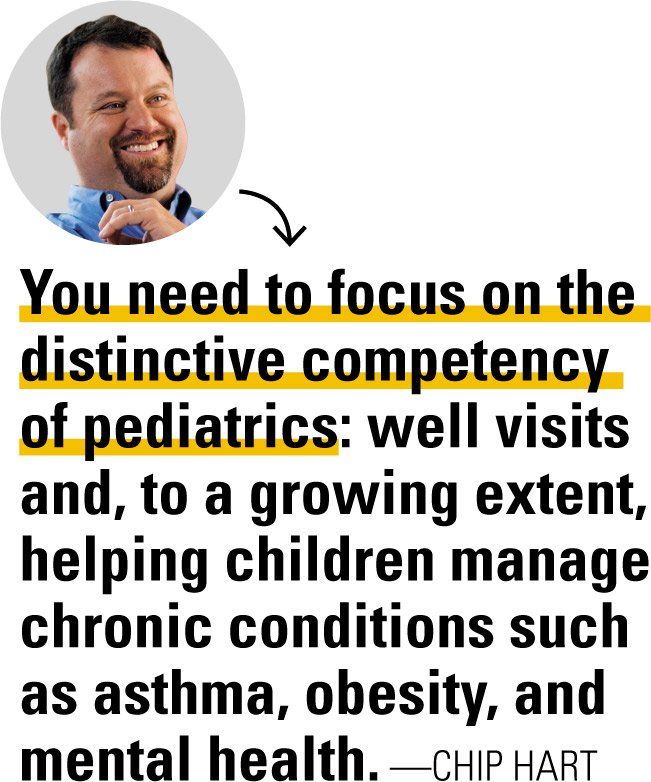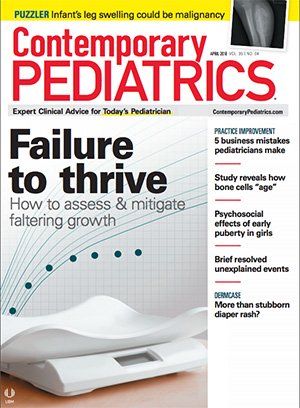The 5 biggest business mistakes independent pediatricians make
Independent pediatricians truly are small service business owners. Expert advice can help your practice avoid problems and achieve success.
Chip Hart

In nearly 30 years of visiting independent pediatric practices all over the country, I’ve learned that the biggest challenges that confront you are self-inflicted. That’s right-more than the insurance companies who behave like organized crime, more than the government mandates that force you to click nonsensical boxes in your electronic health record (EHR), and even more than all the ridiculous paperwork and cuts to Medicaid-the most important business problems you face start in your own office.
Too many pediatricians fail to operate like the small service businesses you really are. In your exam room, you are in control and get immediate, positive feedback about the work you do. However, making changes to your small business isn’t easy and your practice gets stuck in a rut.
Being a good, or even great, pediatrician is no longer enough to be a successful pediatrician.
Why do good independent pediatricians fail to be successful? How can you get out of the rut?
1. Focus on preventive care and chronic disease management.
This topic alone could fill an entire issue of Contemporary Pediatrics. If your practice depends on 100ÃÅ¡F fevers, runny noses, and diaper rashes to fill your schedule, your days are numbered. The retail and minute clinics of the world will gladly take those visits from you. You need to focus on the distinctive competency of pediatrics: well visits and, to a growing extent, helping children manage their chronic conditions such as asthma, obesity, and mental health.
Your connection to parents and helping them raise healthy children are the most important things you can do to stay clinically and financially viable. Preventive care pays well; fills your schedule; is required by your payors; is a crucial part of being a patient-centered medical home; establishes your position as the trusted medical source for your families; and, most of all, it is good for your patients.
2. Do your homework.
Do the small businesses you see on your way to work ignore the data that drive their businesses? Not if they want to stay open for long. Every real estate agency, gas station, and restaurant does its homework to survive. They look at their financial reports on a daily, weekly, monthly, and annual basis. They benchmark their performance against themselves and their peers. They know their targets and they can predict future success and challenges.
If you don’t understand your data, you are in trouble. Who really is your best payor? How much revenue do you generate per visit? What is your well-visit coverage really like? How many opportunities do you miss to provide screening? When is the last time you calibrated your pricing? Are you paying too much for vaccines? What are your staffing ratios? Is your billing staff adjusting off too many charges?
Most importantly, don’t answer any of these questions about your practice based on how you feel. It’s time for evidence-based practice management. You use many different measures to care for your patients, from vital signs to lab results. Can you imagine working without that data? Apply the same thinking to your business.
3. Stop hiding in your office.
Every year, there are a limited number of amazing opportunities to get real, pediatric-specific practice management training and instruction. In addition to the American Academy of Pediatrics (AAP) services, such as the Section on Administration and Practice Management (SOAPM) and their website, there are publications, including Contemporary Pediatrics, and a variety of pediatric practice management blogs you must read.
More importantly: get out of your office. Go to the AAP National Conference and Exhibition or one of the state chapter meetings with good practice management content. Attend one of the handful of private pediatric-specific conferences and events. Check out your EHR vendor users’ meeting. It doesn’t really matter where you go, just get out of your office and away from the safety net of your exam room. All it takes is one good coding or management tip to pay for a few years’ worth of meetings.
Don’t stop there. Have a friend from residency you haven’t seen in years? Call him or her and go visit. Spending a day or 2 in an office that isn’t yours will overwhelm you with ideas for change in your practice. Problems you’ve never been able to solve (or, worse, never knew you had!) will suddenly have solutions. Stop practicing in a silo; go visit a peer.
4. Update your look and feel.
In 2018, it’s obvious to remind people to check their websites and Facebook pages. Your primary audience is mothers, especially young mothers, most of whom are tied to their smartphones.
Is your website up to date? Do your parents have to use the 2-fingered pinch-and-swipe and squint just to see your page? Is your Facebook page active and helpful? Are you sharing good, online pediatric content with your patients?
You are? Good. Then head out into your waiting room, sit in one of your chairs, and look around. Feel under the chair-is there gum? Are there rips or tears? Anything stained? Is this a practice you want to visit?
How are your handouts? Are they up-to-date? Do they look nice, include your contact information, and are they easily shared on your patient portal?
Sit in every chair and visit every room your patients will see in your office. From your patients’ literal perspective, what do they see, hear, feel, smell? Is there a desk that needs to be cleaned, a 4-year-old sign that needs to be removed, a carpet that needs cleaning?
Have a friend visit your office in the middle of the day and ask to meet you without an appointment. Ask parents you know how the experience of booking the appointment and being checked in felt for them. Find out how your staff, the face of your practice, treats people when you aren’t looking.
Don’t forget that only a small part of the experience patients have with your office is with you.
5. Stop working with the wrong people.
Nearly every struggling practice I meet suffers from this malady: They work with the wrong people.
The “wrong” people almost always fall into 1 of 3 categories:
· The incompetent-or wildly divisive-high-ranking employee who has been there forever but whom you “just can’t do without.” You can do without, and the sooner, the better. I’ve never, even once, had a practice call me to say, “I wish I had taken longer to fire my office manager.” It’s always, always, recognition that it should have been done sooner.
· The underpaid, underorganized, low-ranking employee whom no one takes the time or effort to shape up because they ship out on their own every couple of months. I hear it all the time: “We can’t find good people!” You know why? Because smart businesses create and keep their good people. Good people don’t just turn up-you have to make them.
· The last and most important category: your partners. At least a half-dozen times a year I meet with practices that should consider “breaking up” but just don’t want to face it. Do you disagree strongly with any of your partners, clinically or financially? Is someone a bully or not at all attentive to partner duties? Do you feel like you do all the management work? Are you ready to embrace the changes facing your practice, but others want to keep doing things the way they’ve always been done?
If you and your partner(s) aren’t working well together, fix it or move on. Life is too short to be miserable or to be forced to practice in a manner you don’t enjoy. A business partnership is not like a marriage. There are no moral implications of promises made at the altar. Now is the time to create the work environment that you want.
Over the last few years, the consultants I know have been busy with startup practices born from pediatricians with high standards leaving their large healthcare systems or hospitals. For most communities in the United States, this is an amazing time to be a pediatrician. Don’t let that opportunity slip by because you were tethered to the wrong people.
Owning a small business is not easy, especially with the increasing demands of your customers, new daily paperwork requirements, and what feels like diminishing financial return. For pediatricians, at least, the rewards, both intrinsic and external, are substantial. Think about each of the common business mistakes above and pick one to address this quarter. I promise that you won’t regret it. Measure the impact, share your victory, and keep moving forward.
For Chip Hart’s webinar series about the 5 biggest business mistakes independent pediatricians make, visit bit.ly/2on4Hal
For more about remaining independent, visit www.independentpediatrician.com/

Anger hurts your team’s performance and health, and yours too
October 25th 2024Anger in health care affects both patients and professionals with rising violence and negative health outcomes, but understanding its triggers and applying de-escalation techniques can help manage this pervasive issue.